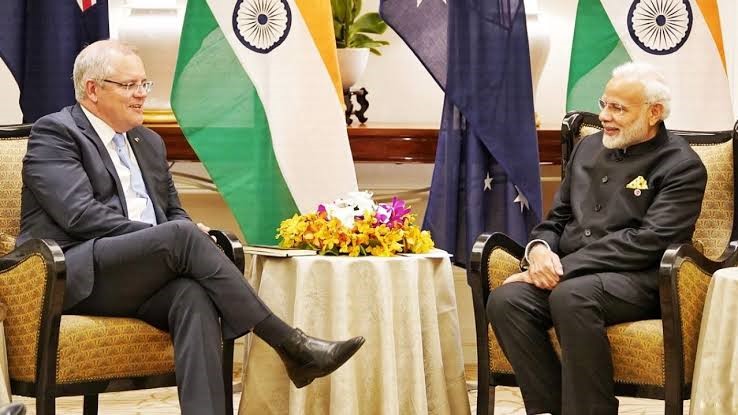REDEFINING INDIA-AUSTRALIA STRATEGIC PARTNERSHIP
REDEFINING INDIA-AUSTRALIA STRATEGIC PARTNERSHIP
Syllabus:
GS Paper – 2
Government Policies & Interventions , Bilateral Groupings & Agreements , Groupings & Agreements Involving India and/or Affecting India’s Interests , Effect of Policies & Politics of Countries on India’s Interests
Why in the News ?
On June 4, 2025, Australia’s Deputy Prime Minister and Defence Minister Richard Marles visited New Delhi to commemorate the 5th anniversary of the Comprehensive Strategic Partnership (CSP) between India and Australia. This moment marks a critical inflection point to recalibrate the bilateral agenda amidst growing Indo-Pacific uncertainties and geopolitical realignments..
STRATEGIC MILESTONE
- CSP Foundation: The Comprehensive Strategic Partnership, launched in 2020, symbolised shared interests in a free, open, and inclusive Indo-Pacific amidst the global flux.
- Geopolitical Alignment: Both countries have demonstrated a convergence of values, especially in democratic governance, regional security, and multilateral cooperation.
- Indo-Pacific Focus: The partnership is anchored in Indo-Pacific regional stability, making it a crucial bilateral force in shaping new security architectures.
- Multifaceted Growth: CSP has facilitated deeper defence cooperation, economic ties, tech linkages, and people-to-people exchanges, showcasing its multidimensional scope.
- Strategic Timing: In a time of heightened great power competition, this anniversary is a timely opportunity to reimagine and expand the bilateral vision.
ECONOMIC REIMAGINATION
- Beyond Tariffs: The Economic Cooperation and Trade Agreement (ECTA) should evolve into a Comprehensive Economic Cooperation Agreement (CECA) covering services, investments, and digital trade.
- Capital Mobilisation: Australia’s AUD 4 trillion superannuation fund presents untapped potential for India’s green infrastructure and digital economy.
- Risk Mitigation: India could establish a sovereign risk mitigation facility to de-risk and attract Australian investments in priority sectors.
- Trade Diversification: A future-ready CECA must ensure regulatory harmonisation, IPR frameworks, and investment facilitation across digital, financial, and creative sectors.
- Institutional Ties: Creating structured trade dialogues and investment forums can boost confidence and overcome existing economic asymmetries.
RESOURCE DIPLOMACY
- Critical Minerals: The 2022 Critical Minerals Investment Partnership remains underutilised despite rising demand for clean energy materials.
- Formal Mechanism: A Joint Critical Minerals Development Corporation should be institutionalised with concessional finance and tech collaboration.
- Supply Security: This partnership is key to de-risking global supply chains, especially from Chinese dependency in rare earth elements.
- Export-Import Links: Export-import frameworks should be aligned with bilateral strategic needs, enhancing resource-based diplomacy.
- Policy-Industry Bridge: Institutional mechanisms can bridge the policy-commercial gap, ensuring that resource cooperation translates into real-world outcomes.
DEFENCE SYNERGY
- Industrial Push: India’s Atmanirbhar Bharat vision offers scope for joint defence R&D, co-production, and innovation, especially in niche areas.
- MSME Linkages: A Defence Innovation and Industrial Corridor connecting Indian and Australian MSMEs and universities could drive mutual defence manufacturing.
- Emerging Tech: Cooperation in undersea surveillance, autonomous maritime platforms, and space-based intelligence needs greater strategic focus.
- Trilateral Scope: Defence initiatives can be expanded through Quad platforms, enhancing shared maritime and cyber capabilities.
- Procurement Pathways: Fast-tracking joint procurement and logistics agreements would streamline operational synergies during emergencies.
DIASPORA DYNAMICS
- Fringe Tensions: Diaspora frictions—especially Khalistani separatism—have occasionally strained relations due to misinformation and political sensitivities.
- Law & Dialogue: Alongside law enforcement, a long-term approach requires strategic diaspora engagement through institutional dialogues.
- Dialogue Forum: An India-Australia Diaspora Dialogue Forum involving civil society, academics, and youth could strengthen mutual understanding.
- Public Diplomacy: India’s soft power must evolve into policy-led public diplomacy, involving youth fellowships, think tank collaborations, and civic initiatives.
- Community Anchoring: Diaspora relations must be embedded in shared civic values, helping both governments manage potential polarisation.
KNOWLEDGE CORRIDOR
- Education Mobility: Beyond Indian students in Australia, bilateral focus must now include faculty exchanges, research collaborations, and joint degrees.
- Indo-Pacific University: Establishing a bi-national University of Indo-Pacific Studies would institutionalise research in AI, maritime law, and public policy.
- Innovation Linkages: An Australia-India Innovation Corridor can connect IITs, Australian universities, and private R&D for joint tech solutions.
- Qualification Gaps: Fast-tracking mutual recognition of degrees and faculty mobility reforms is essential for seamless academic cooperation.
- Institutional Footprint: The opening of Deakin University’s campus in GIFT City and University of Melbourne’s centre in Delhi signals new momentum.
Conclusion
The India-Australia CSP has achieved much in five years, but the road ahead demands bold reforms, institutionalised frameworks, and a future-ready vision. A recalibrated partnership can become not just a bilateral success but a regional anchor for peace, innovation, and inclusive growth in the rapidly evolving Indo-Pacific landscape.
Source:HT
Mains Practice Question
Q. India and Australia’s Comprehensive Strategic Partnership (CSP) has laid a strong foundation for bilateral cooperation. Discuss how both countries can recalibrate this relationship to address emerging regional challenges and unlock future opportunities. Suggest concrete institutional mechanisms across strategic, economic, and knowledge domains.




